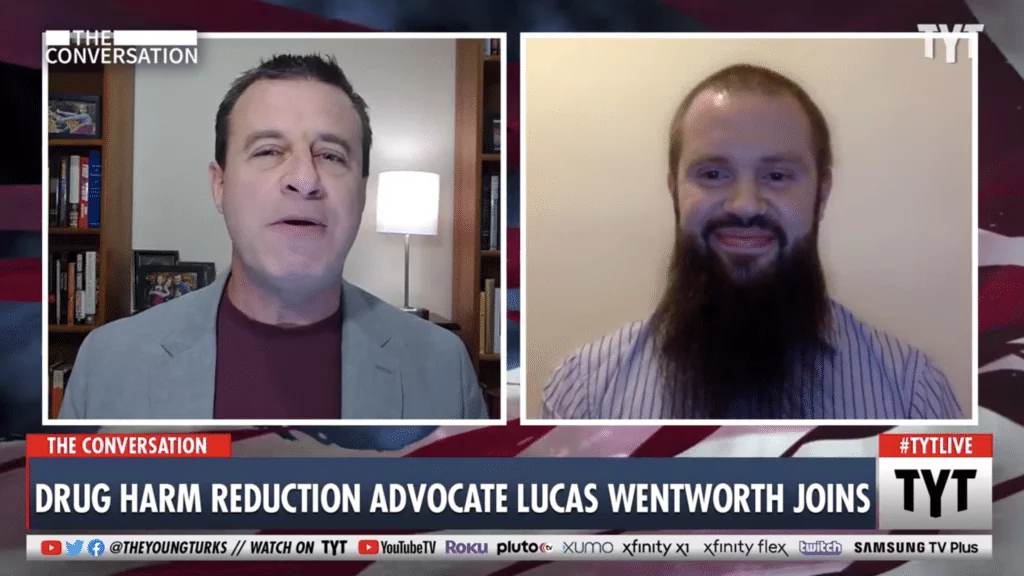Lucas Wentworth is a crucial part of the team of cannabis and psychedelic marketing experts at NisonCo PR. In 2018, he was initially hired as an Account Coordinator and was promoted to Account Manager a year later.
Lucas is involved with local grassroots harm reduction efforts. In addition to distributing Narcan and other important tools to the surrounding community, he’s also involved in state lobbying for vital drug policies.
Alongside other activists and organizers, Lucas is currently advocating for NY State Assembly Bill A6179, which would mandate public schools to teach about the existing 911 Good Samaritan Law to high school students. Currently, information about the law isn’t part of the public school drug education curriculum.
As part of our ongoing Crafting a Cannabis Professional staff interview series at NisonCo PR, we interviewed Lucas about his experience utilizing the 911 Good Samaritan Law himself as a teen and advocating for harm reduction policy at the state level. See below for our conversation, as well as a video of another recent interview with Lucas about harm reduction conducted by The Young Turks.
Adryan: In your interview with The Young Turks, you discussed your personal experience with someone overdosing at a party as a young adult. You knew no one would be penalized for calling 911 to report the crisis because your mom was an informed social worker and taught it to you. How did this experience shape your advocacy in harm reduction?
Lucas: That experience was the key point in my life that led me to be involved in harm reduction education and advocacy initiatives. Prior to the party, I’d been aware of harm reduction as a concept, but in such a situation, realizing that a law I had been taught about off-hand would help us both save the person’s life and protect everyone else’s rights was revolutionary to me. Since that night, I’ve been involved with harm-reduction-focused activist groups doing street outreach, offering naloxone, fentanyl test strips, and sharps containers, as well as relevant trainings.
A: Although New York’s 911 Good Samaritan law went into effect in 2011, it’s not necessarily common public knowledge. You advocate for this policy being taught in public schools to promote awareness among young adults. Can you expand on this?
L: We’re pushing for this education mandate (A6179) because it is a common-sense extension of the Good Samaritan Law from 2011. The law is a fantastic example of a harm reduction policy — but in truth, it’s only as helpful as the number of people who are aware of it and how it protects them as well as others. By including conversations about our state’s Good Samaritan Law in public high school health classes, we believe we have identified the most systematic approach to ensuring generations of New Yorkers are aware of it. This bill will save lives in every community of our state.
A: There is a growing interest in modifying existing drug education programs to make them more scientifically and historically accurate. Drug Policy Alliance’s Safety First program is a great example. Why is it important to teach young people harm-reduction measures in school?
L: Our youth are the front lines of the opioid epidemic in many ways. These are the people who are most afraid of calling 911 to respond to a medical emergency because they don’t want to see their parents, guardians, or friends get taken away for using drugs — let alone themselves for being in the vicinity. It’s very important that these young people know they and the overdose victim are protected by law from prosecution.
A: Likewise, why is abstinence-only, a la D.A.R.E. drug education harmful, unhelpful, and unrealistic for young adults?
L: Abstinence-only drug education is unhelpful and even harmful for the same reason abstinence-only sex education is useless. People have sex. People indulge in intoxicants of various kinds. They always have and always will — and an authority telling them “no” won’t change that for the majority of people. Therefore, it’s extremely important to mitigate any possible risks associated with drug-using activities and ensure people who use drugs (PWUD) are able to use their chosen substances safely.
A: Beyond the Good Samaritan law, what other harm reduction topics would you like to see taught to young adults more broadly?
L: I would love to see high-school- or even middle-school-aged young people learn how to provide Narcan (naloxone) in an emergency, as well as how they can obtain it. It’s basic first aid at this point. I would also like to see youth educated about how to spot a drug or alcohol overdose before they reach their freshman year of college — which in my experience is when that education takes place.
New York state residents can take action right now to support A6179. Input your name and address into this call to action, auto-mailer link tool, which will identify your Assemblyperson and auto-generate an email for you to review, edit, and send.
At NisonCo we are proud to support causes that reduce harm reduction, and further service public health. We offer pro bono PR services for movements and business practices that advance social justice. Click here to get in touch with us today.


